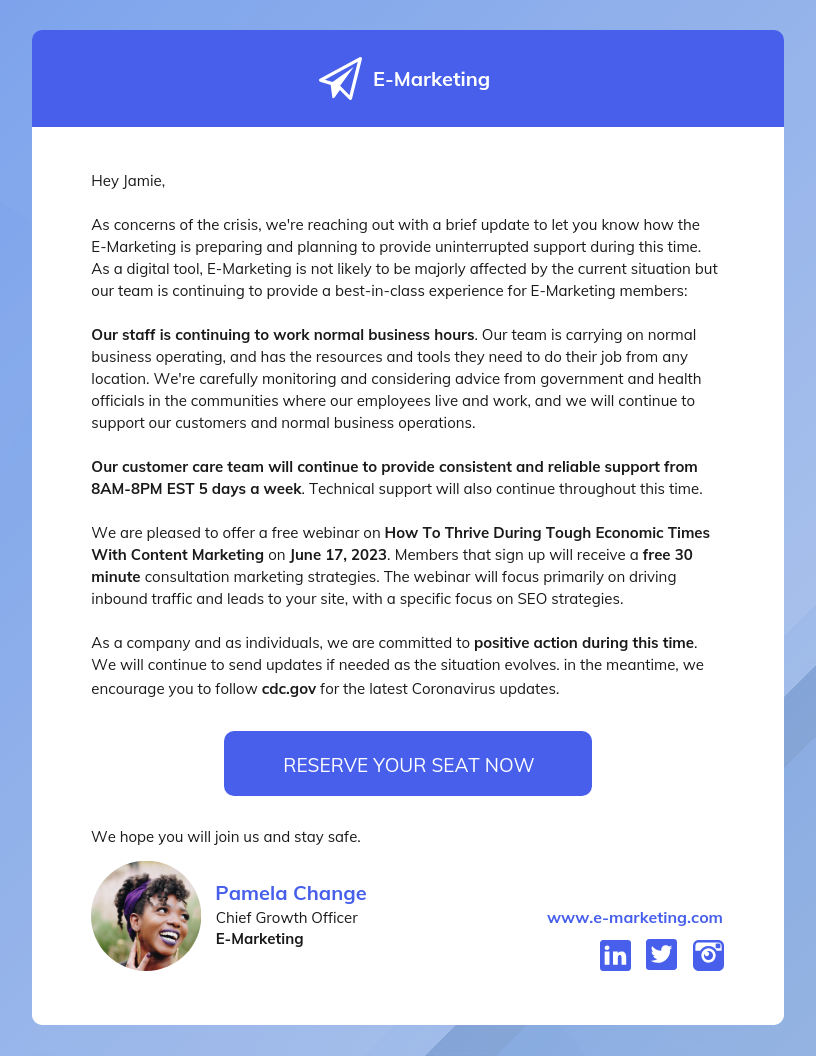In the realm of digital communication, emails remain a cornerstone for businesses to connect with their audiences. Email templates professional provide a powerful tool to streamline email marketing efforts, ensuring consistent and impactful communication.
With pre-designed templates tailored to various purposes and industries, businesses can save time and resources while maintaining a professional and polished brand image.
Email Template Types
Email templates are pre-designed layouts that help businesses create professional-looking emails quickly and easily. They come in various types, each suited for specific purposes.
Using pre-designed email templates offers numerous benefits, including:
- Time-saving: Templates eliminate the need to design emails from scratch, saving businesses valuable time.
- Consistency: Templates ensure that all emails from a business have a consistent look and feel, reinforcing brand identity.
- Improved readability: Templates are optimized for readability, ensuring that emails are easy to read on any device.
Types of Email Templates
| Type | Use | Example |
|---|---|---|
| Welcome Email | Welcoming new customers or subscribers | Introducing the brand, providing essential information, and offering a special offer |
| Newsletter | Sharing regular updates, promotions, and content | Featuring curated articles, product highlights, and upcoming events |
| Transactional Email | Triggered by specific actions, such as purchases or account updates | Confirming orders, providing shipping information, or sending invoices |
| Promotional Email | Promoting products or services | Announcing new arrivals, offering discounts, or highlighting special deals |
Professional Email Template Elements

Crafting a professional email template is essential for establishing a cohesive and effective communication channel. It ensures consistency in messaging, branding, and overall tone.
Key elements of a professional email template include:
Subject Line
The subject line is the first impression your email makes. It should be concise, attention-grabbing, and accurately reflect the email’s content. Keep it within 50 characters to ensure readability across devices.
Greeting
Start your email with a professional greeting, such as “Dear [Recipient Name]” or “Hello [Recipient Name].” Avoid using generic salutations like “To whom it may concern” or “Dear Sir/Madam.”
Body
The body of the email should be clear, concise, and well-organized. Use short paragraphs, bullet points, and headings to make it easy to read and skim. Highlight important information and use a call-to-action to guide the recipient towards the desired response.
Call-to-Action
A clear call-to-action tells the recipient what you want them to do next. This could be visiting a website, scheduling a meeting, or providing feedback. Make it easy for them to take action by providing a link or button.
Closing
End your email with a professional closing, such as “Sincerely,” “Best regards,” or “Thank you.” Include your full name and contact information, such as your phone number and email address.
Consistent Brand Voice and Visual Identity
Your email templates should reflect your brand’s voice and visual identity. Use consistent fonts, colors, and logos to create a recognizable and professional look. Ensure that your templates are optimized for both desktop and mobile devices.
Email Template Customization
Customizing email templates allows you to tailor your emails to specific audiences and purposes. This can increase engagement, conversions, and overall email marketing effectiveness.
Here are some ways to personalize email templates:
Dynamic Content
- Use dynamic content to automatically change the content of your emails based on the recipient’s data, such as their name, location, or purchase history.
- This makes your emails more relevant and engaging for each recipient.
Segmentation
- Segment your email list into different groups based on demographics, interests, or behavior.
- This allows you to send targeted emails that are more likely to resonate with each group.
A/B Testing
- A/B testing allows you to test different versions of your email templates to see which one performs better.
- This can help you optimize your email campaigns and get the most out of your email marketing efforts.
Best Practices for Using Email Templates

To effectively use email templates, maintaining a clean and organized inbox is crucial. This ensures quick access to important emails and prevents distractions. Clear and concise language is essential for effective communication, avoiding jargon or technical terms that may not be easily understood by recipients. Additionally, adhering to best practices for avoiding spam filters is essential to ensure your emails reach their intended recipients.
Tips for Optimizing Email Templates for Mobile Devices
- Use a responsive design that automatically adjusts to different screen sizes.
- Keep content concise and avoid overwhelming users with excessive text or images.
- Use large, easy-to-read fonts and avoid small or cluttered designs.
- Ensure that all buttons and links are easily visible and accessible on mobile devices.
- Test your templates thoroughly on different mobile devices to ensure optimal performance.
Email Template Design Inspiration
Searching for innovative email template ideas? Look no further! Check out these smashing examples that’ll make your campaigns stand out.
From slick e-commerce templates to engaging newsletters, we’ve got you covered. Get ready to unleash your creativity and craft emails that pack a punch.
Design Inspiration Resources
- Dribbble: Explore a treasure trove of email template designs crafted by talented designers worldwide.
- Pinterest: Discover a visual feast of email template ideas that cater to various industries and styles.
- EmailOctopus: Get your hands on a curated collection of free and premium email templates designed for specific use cases.
FAQ Summary
What are the key benefits of using email templates?
Pre-designed email templates offer numerous advantages, including saving time and resources, ensuring consistency in branding, enhancing email deliverability, and improving overall campaign performance.
How can I customize email templates to meet specific needs?
Email templates can be easily customized using dynamic content, segmentation, and A/B testing to personalize the content and design based on target audience, campaign goals, and individual preferences.
What are the best practices for using email templates effectively?
To maximize the effectiveness of email templates, it’s essential to maintain a clean and organized inbox, use clear and concise language, avoid spam filters, and optimize templates for mobile devices.
